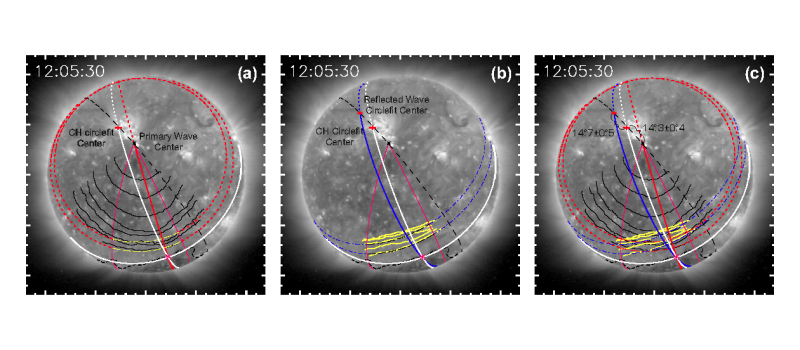Reflection of Coronal Global Waves
| Nugget | |
|---|---|
| Number: | 217 |
| 1st Author: | Ines Kienreich |
| 2nd Author: | Hugh Hudson |
| Published: | January 13, 2014 |
| Next Nugget: | TBD |
| Previous Nugget: | Flare Coronal Rain |
Introduction
Flares and CMEs can excite large-scale waves in the corona, observable by many techniques with our excellent modern data. These global waves can in extreme cases produce the [chromospheric] signature that we call a [Moreton wave], but since Uchida's early interpretative workin terms of MHD wave propagation, we have understood the chromospheric wave to be a consequence of the global wave itself. Controversy has raged on and off regarding the relationships between the globalwaves and their causes (flare [blast wave]? or CME [bow wave]?). In this Nugget we do not discuss the exciters, but only the wave propagation.The particular events studied (see Ref. [1]) occurred on 27 January 2011: SOL2011-01-27T08:50 [B1.1], T12:18 [B1.9] , and T20:03 (C1.5), all from the same active region. This is already interesting, because these are minor flares.The RHESSI Browser shows them, highlighting the 12:18 event because of its association with a radio [type II] event.
This Nugget describes the subsequent propagation of the global waves and reports a new property: the apparently [specular reflection] of the wavesat a distant magnetic domain wall.
Observations
We make use of the EUV images obtained by [STEREO-A] and by [PROBA2]; this epoch put STEREO-A almost at [quadrature], i.e. with a nearly orthogonalview of the events. Thus the analysis of the wave dynamics can delve into the three-dimensional structure, something only possible with STEREO. Figure 1 shows an overview.
